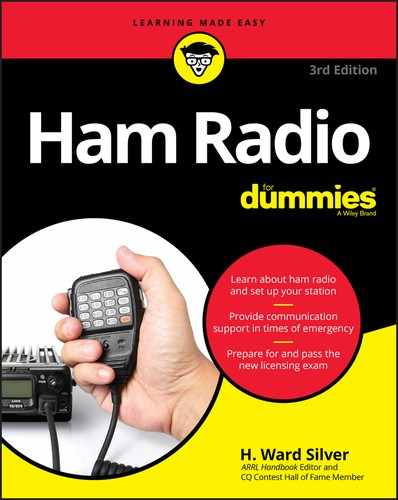Chapter 18
Technical Fundamentals
No matter what interests you in ham radio, from ragchewing to equipment design, you’ll get more out of the hobby if you have a basic understanding of a few technology details. If you want to dive in a little deeper, your license study guides will get you started. The ARRL Handbook and The ARRL Antenna Book have been reliable references for many years. Online you can use the ARRL Technical Information Service (www.arrl.org/technology) that is available to all hams. Appendix B of this book is a radio math supplement that provides some common math formulas you’ll encounter in ham radio.
Electrical Units and Symbols
You should know each of the basic electrical units and what they represent:
- Voltage (volts, V): The electrical potential between two points, represented as V, v, E, or e in equations.
- Current (amperes, A): The electrical charge flowing in a circuit, represented as I or i in equations.
- Power (watts, W): The rate at which energy is expended or dissipated, represented as P or p in equations.
- Resistance (ohms, Ω): Opposition to current flow, represented as R or r in equations. Ω is a capital Greek letter omega.
- Reactance (ohms, Ω): Opposition to AC current flow, represented as X in equations.
- Impedance (ohms, Ω): Combination of resistance and reactance, represented as Z in equations.
- Conductance (siemens, S): The inverse of resistance, represented as G or g in equations.
- Capacitance (farads, F): The ability to store energy as an electric field, represented as C in equations.
- Inductance (henries, H): The ability to store energy as a magnetic field, represented as L in equations.
- Frequency (hertz, Hz): The number of complete cycles per second of an AC current, represented as f in equations.
- Wavelength: The distance covered by a radio wave during the time it takes to complete one full cycle, represented by λ (a lower-case Greek letter lambda) in equations.
Ohm’s Law
The most basic relationship in electronics and radio is Ohm’s Law, which states that the voltage (V, in volts) across a resistance (R, in ohms or Ω) is proportional to the current flowing through it (I, in amperes). Mathematically it looks like this, shown three different ways:
V = I × R |
I = V / R |
and R = V / I |
The first version is why the voltage across a resistor is sometimes referred to as the IR drop. Voltage can also be represented by E.
Power
Another fundamental equation is the Power Equation that shows power (P, in watts) being used or dissipated by a device or component is equal to the voltage across it (V, in volts) multiplied by the current through it (I, in amperes): P = V × I. (Voltage can also be represented by E.)
By substituting the Ohm’s Law relationships for V and I, we also get:
P = V2 / R |
P = I2 × R |
When calculating power in an AC circuit, use the RMS (root-mean-square) voltage measured by a voltmeter.
Transmitter peak envelope power (PEP) is the power measured at the very highest peak of the RF waveform. If you use a wattmeter, be sure it is calibrated to show PEP and not average power.
Attenuation, Loss, and Gain
The decibel (or dB) was introduced in Chapter 12. The decibel is used to measure or specify the changes in signal level corresponding to:
- Attenuation: A reduction in signal level by a circuit, such as a filter or attenuator, or by the signal traveling through a feed line or through space.
- Loss: A reduction in signal level caused by the signal flowing through a component or feed line.
- Gain: An increase in signal level caused by a circuit, such as an amplifier, or by an antenna focusing signals in a preferred direction.
- Effective Radiated Power (ERP): includes both loss and gain in a transmitting station so that the final radiated signal can be compared in strength to a system that uses a reference antenna such as a dipole (ERPD) or an isotropic antenna (ERPI). ERP is given in watts and is equal to the transmitter output power (TPO) plus any gain created by the antenna system less any losses created by the feed line and any feed line components like filters. Both ERPD and ERPI are common.
Bandwidth
Bandwidth is a range of frequencies over which a circuit or signal behaves in some specified way. Figure 18-1A shows a typical signal occupying a channel. The level of the signal is shown by the heavy black line. Two vertical lines show where the signal level is one-half that of the signal’s peak level. The frequency range between the vertical lines is the signal’s bandwidth. Similarly, Figure 18-1B illustrates filter bandwidth. The heavy black line shows the filter response, meaning how much signal is passed or removed by the filter. This notch filter removes signals over a range of frequencies. The range over which the signal coming out of the filter is one-half or less of the signal going in is the filter’s bandwidth. The bandwidths of other filters and signals are measured similarly.

FIGURE 18-1: (A) Signal bandwidth example and (B) a filter bandwidth example.
Filters
A circuit that intentionally increases or decreases a signal’s strength based on its frequency is a filter. (There are other types of filters but this is the most common type.) Ham radio uses a lot of filters! Most are of four common types:
- Low-pass filter (LPF): Attenuates signal level above a cut-off frequency. Generally used to remove unwanted harmonics or signals above the desired range.
- High-pass filter (HPF): Attenuates signal level below the cut-off frequency. Most frequently used to remove hum or buzz and sub-audible signals from audio.
- Bandpass filter (BPF): Attenuates signal level above and below a specified range of frequencies (the passband). Can also be thought of as a combination of high- and low-pass filters.
- Band-stop or notch filter: Attenuates signals over a narrow range of frequencies, shown in Figure 18-2.

FIGURE 18-2: Filter types, showing the responses of low-pass, bandpass, and high-pass filters.
Antenna Patterns
To describe how an antenna focuses a signal from desired directions or rejects signals from unwanted directions, an antenna pattern diagram is used. Figure 18-3 shows the two basic types of antenna patterns. Some common terms related to antenna patterns include the following:
- Azimuthal pattern: This type of pattern (Figure 18-3a) shows the relative signal strength radiated by the antenna in all horizontal directions. It is as if you were looking down on the antenna at the center of the chart. The distance from the center to the solid line shows how strong the signal is or isn’t.
- Elevation pattern: Figure 18-3b shows an antenna pattern from the side, showing how well it radiates at all vertical angles above the ground.
- Null: A point of minimum radiation in the antenna pattern.
- Lobe: The region of the antenna pattern between nulls.
- Front-to-back ratio (F/B): The ratio of signal strengths directly to the front of the antenna (0° in Figure 18-3a) to directly off the back of the antenna (180°).
- Front-to-side ratio (F/S): The ratio of signal strengths directly to the front of the antenna (0° in Fig 18-3a) to the signal strength 90° away from the front of the antenna (90° and 270°).

FIGURE 18-3: Antenna patterns: (a) Azimuthal pattern and (b) Elevation pattern.
Standing Wave Ratio (SWR)
You don’t have to be a radio engineer to use SWR as an indicator for tuning and troubleshooting antenna systems. It basically represents power bouncing around in your feed line until it is radiated by the antenna or dissipated as heat. Lower SWR is good (1:1 is the best), but you don’t have to get too worked up over it. Most transmitters are perfectly happy with SWR values of up to 2:1. For moderate SWR, you can use an antenna tuner. Big changes in or very high values of SWR can indicate a bad connection or other problem.
As SWR increases, so does the amount of signal lost in the feed line since some is lost on each trip back and forth. The additional feed line loss caused by SWR can become significant on the upper HF bands and at VHF/UHF and microwave frequencies.
You’ll encounter the following terms when discussing SWR and how to measure it:
- Standing wave: A pattern of voltage and current in a feed line caused by power reflected from an antenna or load
- Mismatch: A condition where the impedance of the antenna isn’t the same as the characteristic impedance of the feed line
- Directional wattmeter: An RF power meter that can measure power flowing in each direction in a feed line
- Forward power, Pf: Power traveling from the transmitter to the antenna or load
- Reflected power, Pr: Power reflected from a mismatched antenna toward the transmitter
- SWR bridge: A common accessory used to measure SWR directly
SWR = (Pf + Pr) / (Pf – Pr)
Battery Characteristics
There sure are a lot of batteries! You need to know which ones your radio needs as well as how (and whether) to charge them. Start by learning a few terms for when you start shopping:
- Primary: Rechargeable batteries such as lead-acid or Li-ion. Secondary batteries are not rechargeable, such as regular alkaline cells.
- Ampere-hours (A-hr): Battery energy capacity. Since a battery’s output voltage is fairly constant, the time a battery can supply a certain current before voltage begins to drop tells you how much energy the battery can supply.
- Energy density: The amount of stored battery energy per unit of weight (pound or kilogram) or unit of volume.
- Charge profile: The sequence of steps that a charger can take for a specific type of battery.
- Battery chemistry: The types of chemicals that make up a battery and determine both its output voltage and energy density.
For complete information on batteries, battery chargers, and other related topics, check out Battery University (batteryuniversity.com).
Satellite Tracking
You don’t have to be a rocket scientist to know when a satellite is visible to your radio signals and where it will be in the sky. There are terrific tracking programs available from AMSAT (www.amsat.org) and other sources. (Websites like Heavens Above [www.heavens-above.com] show you where the satellites are at any given time, as well.)
To use tracking software, you need a set of data for each satellite called its Keplerian elements. These values describe the satellite’s orbit with enough precision for you to known when and where to aim an antenna at the satellite. Here is a set of “Keps” for recently launched amateur satellite AO-91:
AO-91
1 43016U 17073D 17324.81992359 .00000855 00000-0 73563-4 0 9991
2 43016 97.6901 259.8749 0259544 229.6727 128.1552 14.77757019 356
This is the two-line NASA format. Each piece of data is defined as:
KEY: A-CATALOGNUM B-EPOCHTIME C-DECAY D-ELSETNUM E-INCLINATION F-RAAN
G-ECCENTRICITY H-ARGPERIGEE I-MNANOM J-MNMOTION K-ORBITNUM Z-CHECKSUM
Many tracking software packages can go online and acquire this information automatically without you having to type it in.
You’ll need to be familiar with the following terms to know when to begin listening for the satellite and how to adjust your receiving frequency as the satellite moves past your location:
- AOS: Acquisition of signal. When the satellite’s signal is receivable at your location.
- LOS: Loss of signal. When the satellite’s signal is no longer receivable at your location.
- Doppler (shift): The change in a satellite signal’s frequency caused by its motion. When the satellite is moving toward you, its signal appears to be slightly higher in frequency, and the reverse is true when the satellite is moving away.

 To learn all about SWR in an easy-to-understand presentation, watch the antique-but-excellent AT&T Archives video “Similarities in Wave Behavior” on YouTube at
To learn all about SWR in an easy-to-understand presentation, watch the antique-but-excellent AT&T Archives video “Similarities in Wave Behavior” on YouTube at